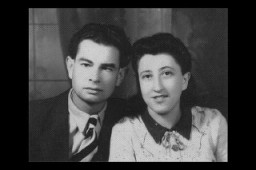You searched for: jewish
<< Previous | Displaying results 426-450 of 2515 for "jewish" | Next >>
-
Vladka (Fagele) Peltel Meed describes clandestine cultural activities in the Warsaw ghetto
Oral HistoryVladka belonged to the Zukunft youth movement of the Bund (the Jewish Socialist party). She was active in the Warsaw ghetto underground as a member of the Jewish Fighting Organization (ZOB). In December 1942, she was smuggled out to the Aryan, Polish side of Warsaw to try to obtain arms and to find hiding places for children and adults. She became an active courier for the Jewish underground and for Jews in camps, forests, and other ghettos.
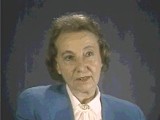
-
Alisa (Lisa) Nussbaum Derman describes joining the Nekama (Revenge) Jewish partisan unit led by Josef Glazman in the Naroch Forest
Oral HistoryLisa was one of three children born to a religious Jewish family. Following the German occupation of her hometown in 1939, Lisa and her family moved first to Augustow and then to Slonim (in Soviet-occupied eastern Poland). German troops captured Slonim in June 1941, during the invasion of the Soviet Union. In Slonim, the Germans established a ghetto which existed from 1941 to 1942. Lisa eventually escaped from Slonim, and went first to Grodno and then to Vilna, where she joined the resistance movement. She…

-
Alisa (Lisa) Nussbaum Derman describes partisan activities
Oral HistoryLisa was one of three children born to a religious Jewish family. Following the German occupation of her hometown in 1939, Lisa and her family moved first to Augustow and then to Slonim (in Soviet-occupied eastern Poland). German troops captured Slonim in June 1941, during the invasion of the Soviet Union. In Slonim, the Germans established a ghetto which existed from 1941 to 1942. Lisa eventually escaped from Slonim, and went first to Grodno and then to Vilna, where she joined the resistance movement. She…
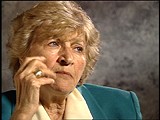
-
Norbert J. Yasharoff describes the change in living conditions for Jews in Bulgaria
Oral HistoryAnti-Jewish measures took effect in Bulgaria after the beginning of World War II. In March 1941, Bulgaria joined the Axis alliance and German troops passed through Sofia. In May 1943, Norbert and his family were expelled to Plevin in northern Bulgaria, where they stayed with relatives. After the advance of the Soviet army in 1944, Norbert and his family returned to Sofia.

-
Frank Bleichman describes conditions in and dangers facing a partisan camp in the forests of Poland
Oral HistoryFrank was one of seven children born to a religious Jewish family in Kamionka, in the Lublin district of Poland. Germany invaded Poland in September 1939. When deportations of Jews from the Lublin area began in 1942, Frank joined a group of Jewish partisans who roamed the forests in search of weapons and food. After obtaining weapons by posing as Soviet paratroopers, they were able to defend themselves against German raids and take revenge against collaborators. They gradually made connections with Polish…
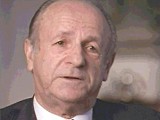
-
Vladka (Fagele) Peltel Meed describes waiting at a train station with false documents to be smuggled into the Warsaw ghetto
Oral HistoryVladka belonged to the Zukunft youth movement of the Bund (the Jewish Socialist party). She was active in the Warsaw ghetto underground as a member of the Jewish Fighting Organization (ZOB). In December 1942, she was smuggled out to the Aryan, Polish side of Warsaw to try to obtain arms and to find hiding places for children and adults. She became an active courier for the Jewish underground and for Jews in camps, forests, and other ghettos.

-
Edward Adler describes arrest and imprisonment in prewar Germany for his relationship with a non-Jewish woman
Oral HistoryEdward was born to a Jewish family in Hamburg. In 1935, the Nuremberg Laws prohibited marriage or sexual relations between German non-Jews and Jews. Edward was then in his mid-twenties. Edward was arrested for dating a non-Jewish woman. Classified as a habitual offender, he was later deported to the Sachsenhausen concentration camp, near Berlin. He was forced to perform hard labor in construction projects. Edward had married shortly before his imprisonment, and his wife made arrangements for their…
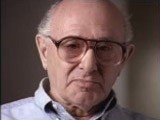
-
Aron (Dereczynski) Derman describes partisan activities near Vilna
Oral HistoryAron was born to a middle-class Jewish family in Slonim, a part of Poland between the two world wars. His parents owned a clothing store. After studying in a technical school, Aron worked as a motion-picture projectionist in a small town near Slonim. The Soviet army took over Slonim in September 1939. War broke out between Germany and the Soviet Union in June 1941. Aron returned to Slonim. The Germans soon occupied Slonim, and later forced the Jews into a ghetto. Aron was forced to work in an armaments…

-
Leo Bretholz describes resistance training and activities in a French underground group he joined in 1943
Oral HistoryAfter the Germans annexed Austria in 1938, Leo attempted to flee. He eventually reached Belgium. In 1940 he was deported to the St.-Cyprien camp in France but escaped. In 1942 Leo was smuggled into Switzerland but was arrested and sent back to France, this time to the Rivesaltes and Drancy camps. He and a friend escaped from a train deporting them to Auschwitz in Poland. Leo joined the French underground in 1943. He arrived in the United States in 1947.
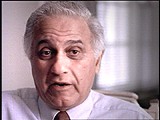
-
Vladka (Fagele) Peltel Meed describes watching the burning of the Warsaw ghetto from a building outside the ghetto
Oral HistoryVladka belonged to the Zukunft youth movement of the Bund (the Jewish Socialist party). She was active in the Warsaw ghetto underground as a member of the Jewish Fighting Organization (ZOB). In December 1942, she was smuggled out to the Aryan, Polish side of Warsaw to try to obtain arms and to find hiding places for children and adults. She became an active courier for the Jewish underground and for Jews in camps, forests, and other ghettos.
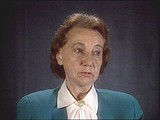
-
Mother and infant daughter in Germany
PhotoIda Baehr Lang holding her infant daughter, Freya Karoline, in Lambsheim. Ida died in the mid-1940s after deportation to Auschwitz. Freya survived in hiding in France and reunited with her father in 1946. Lambsheim, Germany, ca. 1934.

-
Chart illustrating the Nuremberg Laws
PhotoChart illustrating the Nuremberg laws. The figures represent Germans, Jews, and Mischlinge. Germany, 1935.

-
Passport stamped with "J" for "Jude"
PhotoPassport issued to Lore Oppenheimer, a German Jew, with "J" for "Jude" stamped on the card. "Sara" was added to the names of all German Jewish women. Hildesheim, Germany, July 3, 1939.

-
Shimshon and Tova Draenger
PhotoShimshon and Tova Draenger, members of the underground in the Kraków and Warsaw ghettos and partisans in the Wisnicz Forest. Krakow, Poland, date uncertain.

-
House used by members of the Vilna ghetto resistance
PhotoLocated on Ulica Stara (Old Street), outside the Vilna ghetto, this building was used as a safe house by the ghetto resistance. Vilna, after July 1944.
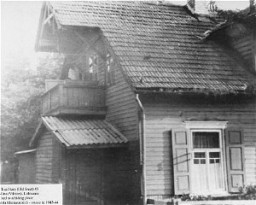
-
Prewar portrait of Ala Gertner
PhotoPrewar photo of Ala Gertner. Bedzin, Poland, 1930s. After being deported to Auschwitz, Ala Gertner took fate into her own hands. Upon arrival, she was assigned to forced labor at a nearby armaments factory. After learning that they were going to be killed, Gertner, along with fellow female prisoners, began smuggling gunpowder and explosives from the factory with plans to destroy one of the crematoriums. During the uprising in October 1944, the prisoners killed three guards. They also set fire to…
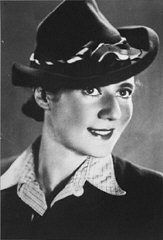
-
Hannah Szenes
PhotoHannah Szenes on her first day in Palestine. Haifa, Palestine, September 19, 1939. Between 1943 and 1945, a group of Jewish men and women from Palestine who had volunteered to join the British army parachuted into German-occupied Europe. Their mission was to organize resistance to the Germans and aid in the rescue of Allied personnel. Hannah Szenes was among these volunteers. Szenes was captured in German-occupied Hungary and executed in Budapest on November 7, 1944, at the age of 23.
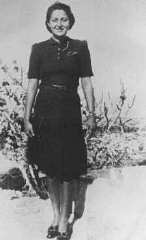
-
Israel Kanal
PhotoIsrael Kanal, a member of the Akiva youth movement and a founder of the Jewish Fighting Organization (ZOB) in Warsaw. He fought in the Warsaw ghetto uprising. Kutno, Poland, ca. 1939.

-
Mordechai Chaim Rumkowski
PhotoMordechai Chaim Rumkowski, Jewish council chairman in the Lodz ghetto, seen here speaking amongst Jewish ghetto policemen. Lodz, Poland, ca. 1942.

-
Mordechai Chaim Rumkowski
PhotoLodz ghetto Jewish council chairman Mordechai Chaim Rumkowski delivers a speech. Lodz, Poland, 1941–43.
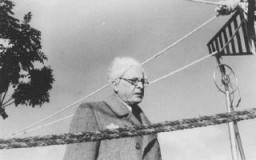
-
A wounded partisan receives medical attention
PhotoA wounded partisan is treated in a field hospital belonging to the Shish detachment of the Molotov brigade. Among those pictured are Dr. Ivan Khudyakov, the brigade's physician (second from the right), and Fanya Lazebnik (Faye Schulman), a photographer and partisan nurse (left). The wounded partisan's name is Sergei. Pinsk, 1942–44.
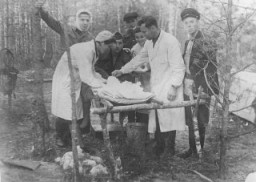
-
Portrait of Josef Kaplan
PhotoPortrait of Josef Kaplan. Kaplan was a youth movement leader. He was also a leader of the Warsaw ghetto underground and Jewish Fighting Organization (ZOB). He was caught preparing forged documents and was killed. Poland, before September 1942.

-
Portrait of Tosia Altman
PhotoPortrait of Tosia Altman (1918-1943), Jewish youth leader and member of the Jewish underground in the Warsaw ghetto.

-
Cover of an underground Yiddish newspaper
PhotoCover of an underground Yiddish newspaper, Jugend Shtimme (Voice of Youth). Writing on the bottom of the cover reads: "Fascism must be smashed." Warsaw ghetto, Poland, January–February 1941.
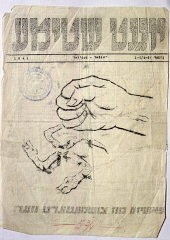
-
